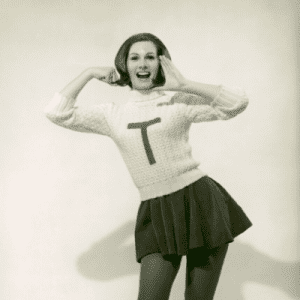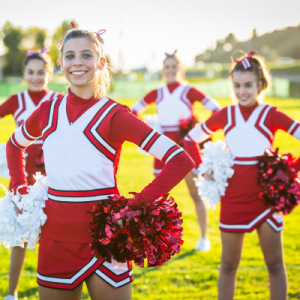In 2003, the University of Maryland became the first Division I NCAA institution to recognize competitive cheerleading as a varsity sport. And what does that mean exactly? It means these athletes have the same benefits as other campus athletes — a coaching and medical staff; locker rooms; help with academics; and help dealing with the press. Currently, Maryland provides 12 full scholarships to competitive cheerleaders.
Defining Competitive Cheerleading as a Sport
First we must define competitive cheerleading as a sport. Competitive cheerleading is similar but is not the same as the cheerleaders you see on the sidelines of your local high school football game or basketball game. And it certainly isn’t anything like what the professional football teams have. These professional cheerleaders more closely resemble dance companies. Competitive cheerleading squads compete against other schools in cheerleading competitions where they perform high-risk routines under high-pressure circumstances.

Competitive cheerleaders have had to endure skepticism from the general population. Many Americans fail to distinguish it from the sideline shows the Dallas Cowboy cheerleaders put on. When in fact, the entire squad is rated on how they perform as a unified body, and on their athletic feats.
Today, more than 200,000 high-school and college students attend cheerleading camps each year; at least 15 percent of them participate in competitions. You can even see some of the national competitions on ESPN. The sport is growing at an accelerated rate.
Will Cheerleading Become an Official Olympic Sport?
There is an ever-increasing hue and cry for cheerleading to be included as an Olympic sport. But what are some of the attributes which might make cheerleading appealing to the Olympic committee and what are some of the pitfalls?
Cheerleaders are fine athletes, to begin with. The amount of time spent training and the conditioning required surely fits the Olympic ideal for athletes. The injuries that cheerleaders often sustain mirrors the same as that of many other events already included as Olympic sports. A high level of cheering skill is exhibited throughout the known cheerleading universe. If curling can be an Olympic sport why not include cheerleading?
Problems with Cheerleading Becoming an Olympic Sport
One of the problems for cheerleading as an Olympic sport is that the judging of the competitions will no doubt be somewhat subjective. Judged events can often lend to controversy. We have already seen in other judged Olympic sports such as figure skating and ice dancing just how biased judges can be.
Another problem is that while cheerleading is a huge sport in the United States and Canada, it is still developing throughout the remainder of the world. It seems that many more countries would have to support cheerleading for there to be any significant international competition. However, it’s fun to imagine the array of cheerleading uniforms and cheerleading chants from countries across the world if cheerleading did become an Olympic sport!
Cheerleading Auditions – Tips and Pointers for Your Next Cheer Audition
If there are cheerleading auditions in your future check out these tips and pointers for cheerleaders of all ages:
Cheerleading Auditions for High School Cheerleading
- Brush up on your gymnastic moves. If you haven’t had a cheerleading gymnastics class before, take one now! Cheerleading is a physically demanding sport, and the sooner you know the basic tumbles, flips, and cheerleading jumps the better.
- Get a copy of the requirements and the general information for the audition. Be sure you meet their qualifications and that you are willing to commit to the responsibilities involved.
- Be on time! Showing up late to an audition indicates to the judges a lack of commitment.
- Always warm-up. Before you start your routine, make sure that you have warmed up those muscles.
- Always look the judges in the eye. This will help you win points.
- Remember to smile. Judges want to see a confident competitor.
- Energy is essential in a cheerleading audition. Don’t be overly enthusiastic that it becomes annoying.
High School Cheerleading Stunts
Being a high school cheerleader is harder than most think. Many think that it is all about glamour and pom-poms, but they just don’t get it. It is about endless hours of training, cheering at games, more training and competing, and all without a thank you or cheer from the crowd. It is a tough sport that gets more and more competitive each year. That is why there are so many new high school cheerleading stunts out there. Each school is trying to make a name for them by creating a stunt that will blow their minds. As the stunts get harder and harder, they get even more dangerous. There are certain safety techniques that cheerleaders must understand before performing any stunts.
High school cheerleading has become more popular over the past few decades. As with any sport, the more competitors mean the more accidents. In 2004, there was a girl that was killed by a cheerleading stunt. It sparked media frenzy across the nation, showing the dangers of cheerleading. Since then, there has been a complete turn around in cheerleading. Instead of performing the hardest stunts without little technique or safety precautions, each stunt is studied to make sure that it is safe enough. High school cheerleading stunts have become more difficult, but they have also become safer. They are required to have more bases and backups so that they can ensure the safety of the cheerleaders. There are a few tips that you want to think about before sending your cheerleader off to competition or practice:
-
- Make sure that the cheerleading coach is certified and trained for the job.
-
- Read the American Association of Cheerleading Coaches and Advisors’ safety guidelines.
-
- Be sure that the cheerleaders practice and perform with a trained coach at all times.
-
- Make sure that the cheerleaders know their level of cheering. Do not let them perform at a higher level when they have not mastered the level below.
-
- Warm-up exercises and stretches are vital before and after practice
-
- If your child injures themselves, make sure that they get the proper medical care.
- Make sure that the cheerleaders surrounding your child are well informed of these tips
High School Cheerleading Stunts
Being a high school cheerleader is harder than most think. Many think that it is all about glamour and pom-poms, but they just don’t get it. It is about endless hours of training, cheering at games, more training and competing, and all without a thank you or cheer from the crowd. It is a tough sport that gets more and more competitive each year. That is why there are so many new high school cheerleading stunts out there. Each school is trying to make a name for them by creating a stunt that will blow their minds. As the stunts get harder and harder, they get even more dangerous. There are certain safety techniques that cheerleaders must understand before performing any stunts.

High school cheerleading has become more popular over the past few decades. As with any sport, the more competitors mean the more accidents. In 2004, there was a girl that was killed by a cheerleading stunt. It sparked media frenzy across the nation, showing the dangers of cheerleading. Since then, there has been a complete turn around in cheerleading. Instead of performing the hardest stunts without little technique or safety precautions, each stunt is studied to make sure that it is safe enough. High school cheerleading stunts have become more difficult, but they have also become safer. They are required to have more bases and backups so that they can ensure the safety of the cheerleaders. There are a few tips that you want to think about before sending your cheerleader off to competition or practice:
-
- Make sure that the cheerleading coach is certified and trained for the job.
-
- Read the American Association of Cheerleading Coaches and Advisors’ safety guidelines.
-
- Be sure that the cheerleaders practice and perform with a trained coach at all times.
-
- Make sure that the cheerleaders know their level of cheering. Do not let them perform at a higher level when they have not mastered the level below.
-
- Warm-up exercises and stretches are vital before and after practice
-
- If your child injures themselves, make sure that they get the proper medical care.
- Make sure that the cheerleaders surrounding your child are well informed of these tips
Cheerleading Mats
Imagine a cheerleader being thrown ten to fifteen feet in the air with nothing but cement under them. This would be horrible if they were not caught and then landed on the ground. This is a move that cheerleaders do every day and luckily cheerleading mats have been developed for such stunts.
Although a majority of the time they are only used during practice, cheerleading mats give the cheerleaders the freedom to do the tumbling and stunts with the knowledge that if they fall, there will be comfort below them.
What Makes Cheer Mats Different
For those of you who think a mat is a mat, think again! There are many different sizes, thicknesses, and styles of mats. The most common is mat comes in either a 4’x6′, 4’x8′, 5’x10′ or 6’x12′ length with a thickness of approximately 1 ½” to 2 ½”. This is a mat that many manufacturers keep in stock and is typically divided into either four or six 2′ sections that allow for the mat to fold for ease of storage. The inside of most mats consists of cross-link polyethylene foam. The cover is typically manufactured out of a coated polyester/vinyl fabric. This allows for the best puncture and tears resistance. Another great cosmetic benefit is that these mats typically come in a variety of colors. The list price formats such as these can range anywhere from $250 all the way up to $700 or more. It all depends on the size of the mat and the material used in manufacturing.
































